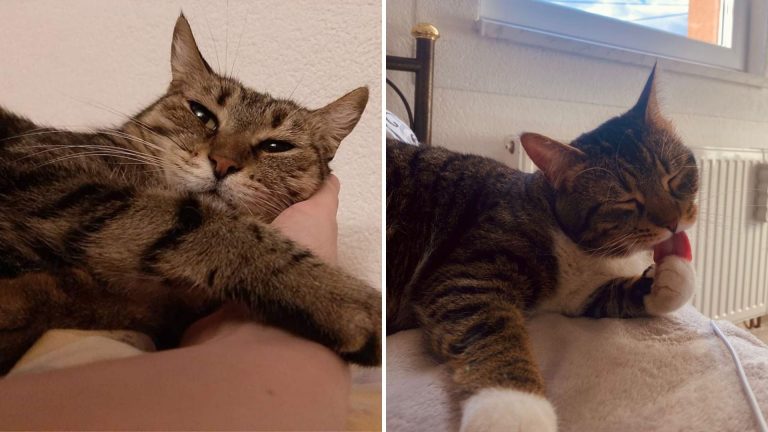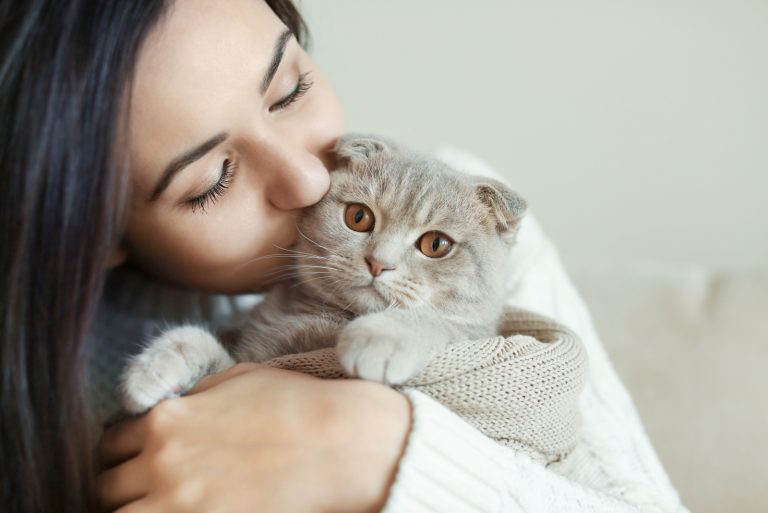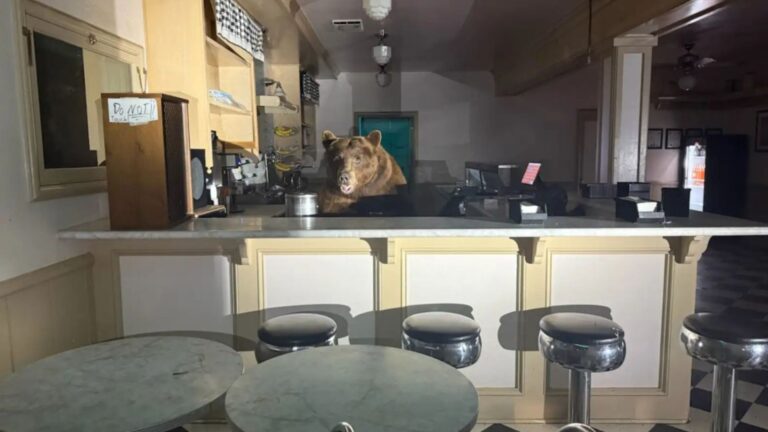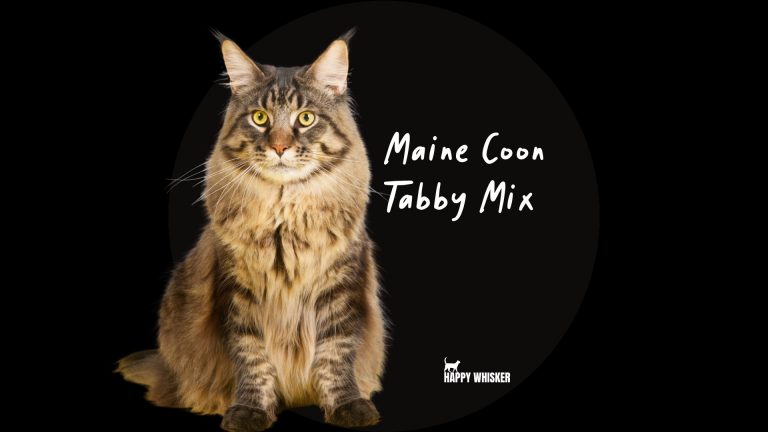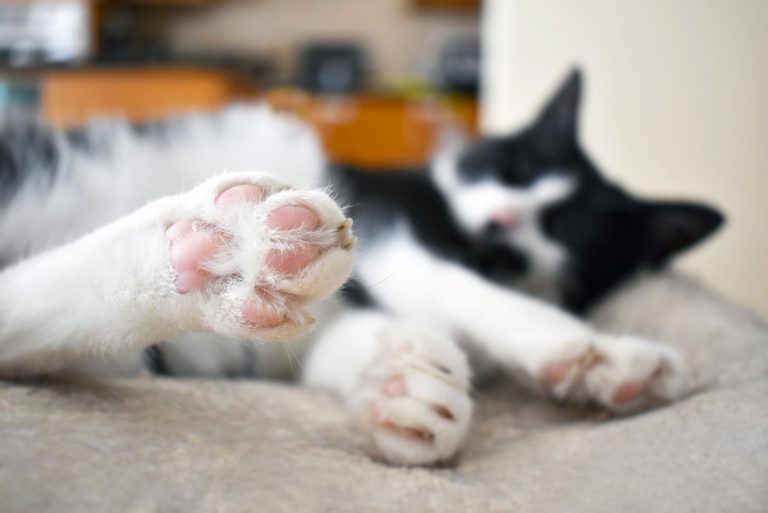Black Specks: Acne Or Flea Poop On Cat Chin? Explained Below
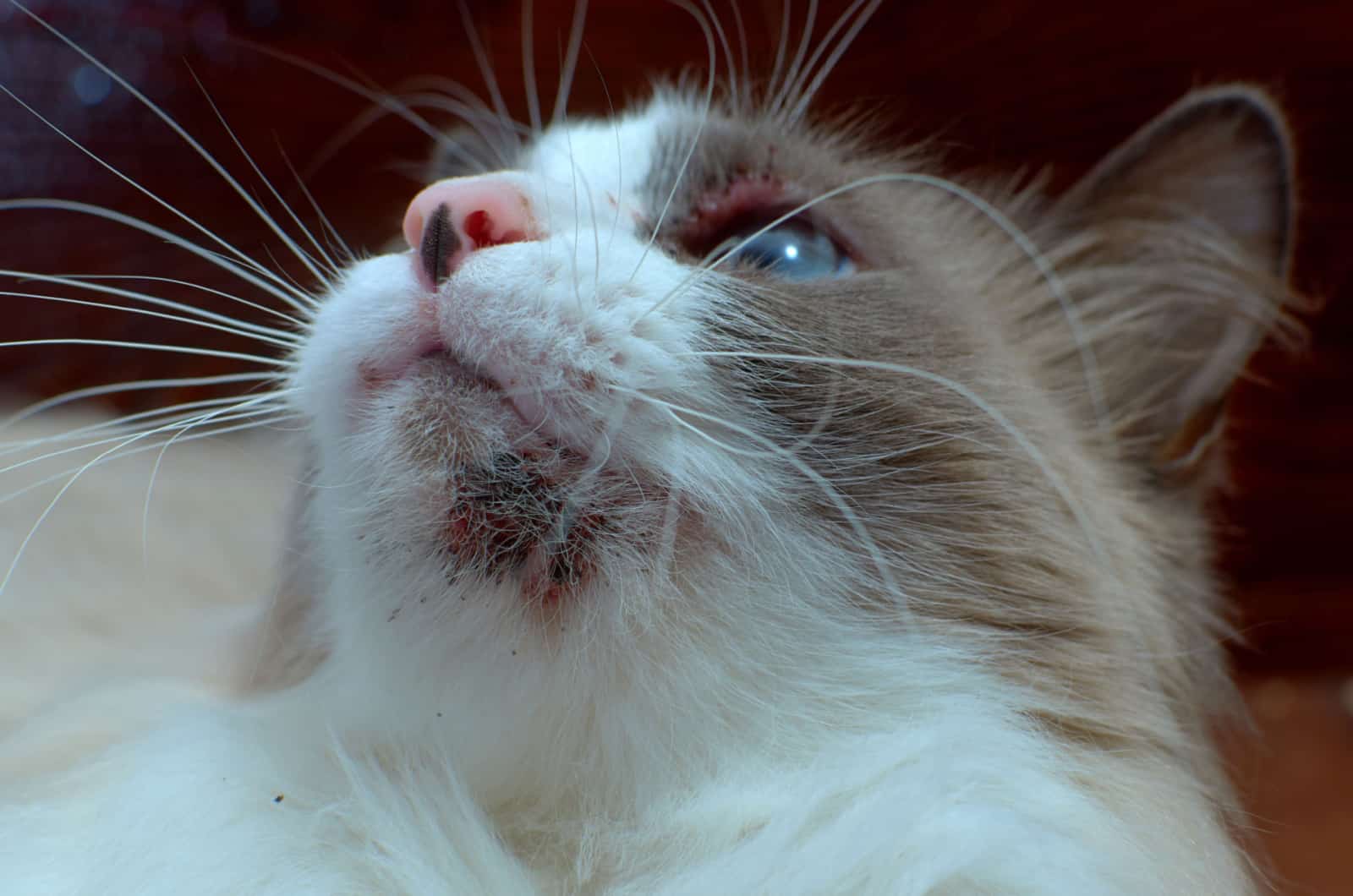
You’re probably here because you’ve recently had a cat flea problem. Or perhaps you have seen some black specks on your cat’s chin but you don’t yet know what is causing them. A lot of pet owners, especially when they encounter this for the first time, can’t tell whether the black specks are flea poop on cat chin or cat acne.
You’re probably thinking, how can my indoor cat or my dog or have fleas? It can happen! Flea infestation happens quite easily, and it can happen to any cat or dog.
Perhaps you have recently taken your cat into the garden or out for a walk, or you’ve visited the vet. You might think that an infestation cannot happen so quickly, but it can.
Unfortunately, fleas are inevitable, which is why regular flea prevention treatments are always recommended for all pets who are susceptible to these parasites, both indoor and outdoor animals.
Fleas usually aren’t dangerous, but they are irritating and can lead to more severe health issues if left untreated. They can also bite humans which can be itchy and uncomfortable. Now let’s see how you can discern whether the black specks are flea poop on cat chin or cat acne, and how to prevent and treat each of them.
Flea Poop On Cat Chin
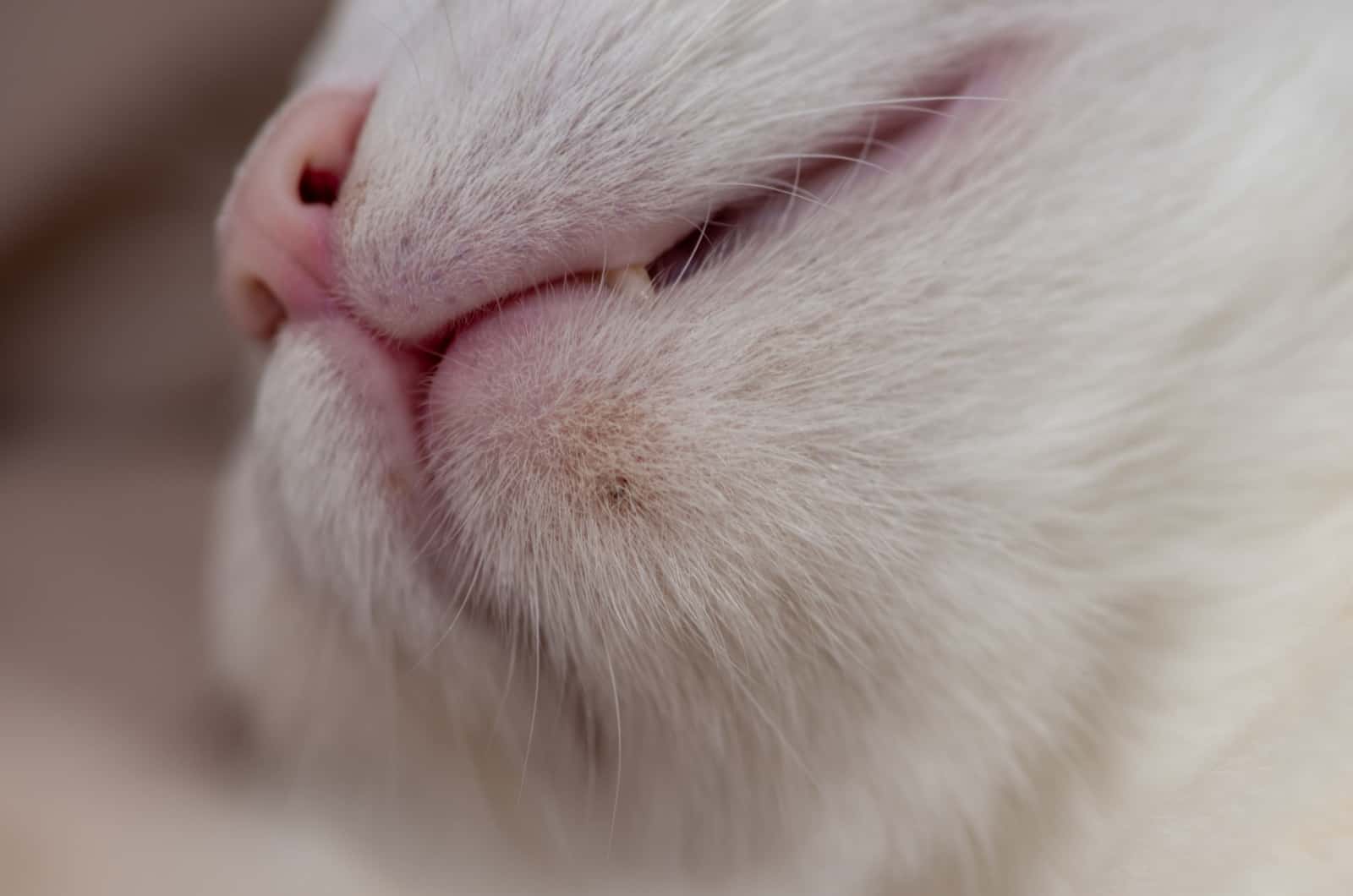
Flea poop, as the name suggests, is the feces that fleas leave behind. If you noticed flea dirt on your cat, then there must be fleas present as well. If flea poop is present, it means that your cat has had fleas for some time now as fleas can only digest and poop out the blood they have ingested if they’ve been living on the cat for some time.
It isn’t always easy to spot flea poop on your cat; it’s often easier to see it on dogs. However, if you suspect your cat has fleas but can’t see any when examining your cat, you can check the cat’s most frequent sleeping spot.
If there are any dark-red or black specks, wipe them with a piece of cloth or white paper. Then, put some water on it, and if it turns red, or if it leaks a red color, then you’ll know it’s flea poop. The red color is blood that has not been fully digested.
Where To Check For Flea Dirt
Usually, flea poop and flea infestation are most prevalent around the back part of your cat’s body. Flea dirt looks like little black pepper-like flecks that are usually round in shape.
Flea dirt can be found in your dog’s or cat’s fur or on their skin. To split the hair to better see any flea poop—or the actual fleas—run a flea comb or your fingers against the growth of the animal’s hair.
Fleas often favor the back of your pet, especially around the tail and up the middle of the body, as well as the genital area and between the rear legs. They will typically stay away from the head and neck region. However, this is not always the case.
There are instances when a pet owner notices flea poop but no fleas. This might suggest that the fleas were consumed by the cat when grooming or that they jumped off but were recently there.
Fleas only spend a small portion of their lives on pets; the rest of the time, they live in your garden or home, and they can even spend most of their life cycle without inhabiting a pet again. Check your pet’s favorite places for further evidence so you know whether you’ll need to treat these spots as well as treating your cat.
Flea Poop – Is It Dangerous?
Flea poop indicates that fleas were recently there on your cat or in your household. Fleas may soon become a major issue as their population grows, dangerously infesting your cat and household surroundings.
Not only may repeated flea bites bother and itch your cat, but some cats may be sensitive or even allergic to flea secretions. An allergic reaction to fleas can result in rashes and hair loss.
Furthermore, certain fleas may transmit infections and/or diseases that can be transferred to your cat and to other people. So, if you see flea poop, there are most certainly fleas beneath it, and it’s critical to act fast before the problem gets worse.
It’s not an emergency, or an extremely dangerous situation, but it does need your attention and it’s important that it is taken care of as soon as possible. Flea poop can be treated, so it’s not alarming, but it can be dangerous if left untreated.
If you’ve treated your cat for fleas and thought you had gotten rid of live fleas, larvae, or flea eggs, and you still notice these little black spots, then it means that your flea prevention treatment didn’t work.
Fleas can trigger numerous diseases; flea poop and adult fleas that leave their poop in the cat’s fur can transmit parasites such as tapeworms or mites, or bartonellosis; i.e. cat scratch fever, which can be transferred to people as well.
Prevention & Treatment
The first step in treating fleas is to bathe your cat with a cat-safe shampoo designed to get rid of fleas. Thoroughly bathe and wash your cat and remove any flea dirt you can. If your cat is really filthy, you might need to do a couple of rounds of shampooing.
The next step is to use a flea comb and go through your cat’s fur gently and thoroughly, so you remove all remaining fleas and flea poop from the cat’s skin and fur.
Beware of fleas, and always keep in mind that both dogs and cats can have them at any time. Fleas are irritating, and if left untreated, they can cause many health issues for our beloved pets.
You should have a regular flea treatment routine, providing your pets with preventative treatments throughout the entire year, every year.
If you haven’t had to buy flea prevention products before, consult your vet and get advice on the most suitable option for flea control for your cat. Look into flea collar options available, and choose whichever suits your needs best.
As far as your home is concerned, you should clean, and then clean some more. Wash your cat’s beds, and thoroughly clean your cat’s tree, toys, and all the comfy spots your cat loves. Vacuum and clean the entire house, especially the carpets and any cracks between floorboards.
Fleas can live for quite some time in your household carpets and wooden floors and they are most usually found in bedrooms and living rooms, which isn’t surprising since those are the places with the most soft furnishings and where we spend most of our time at home.
Cat Acne On Cat’s Chin
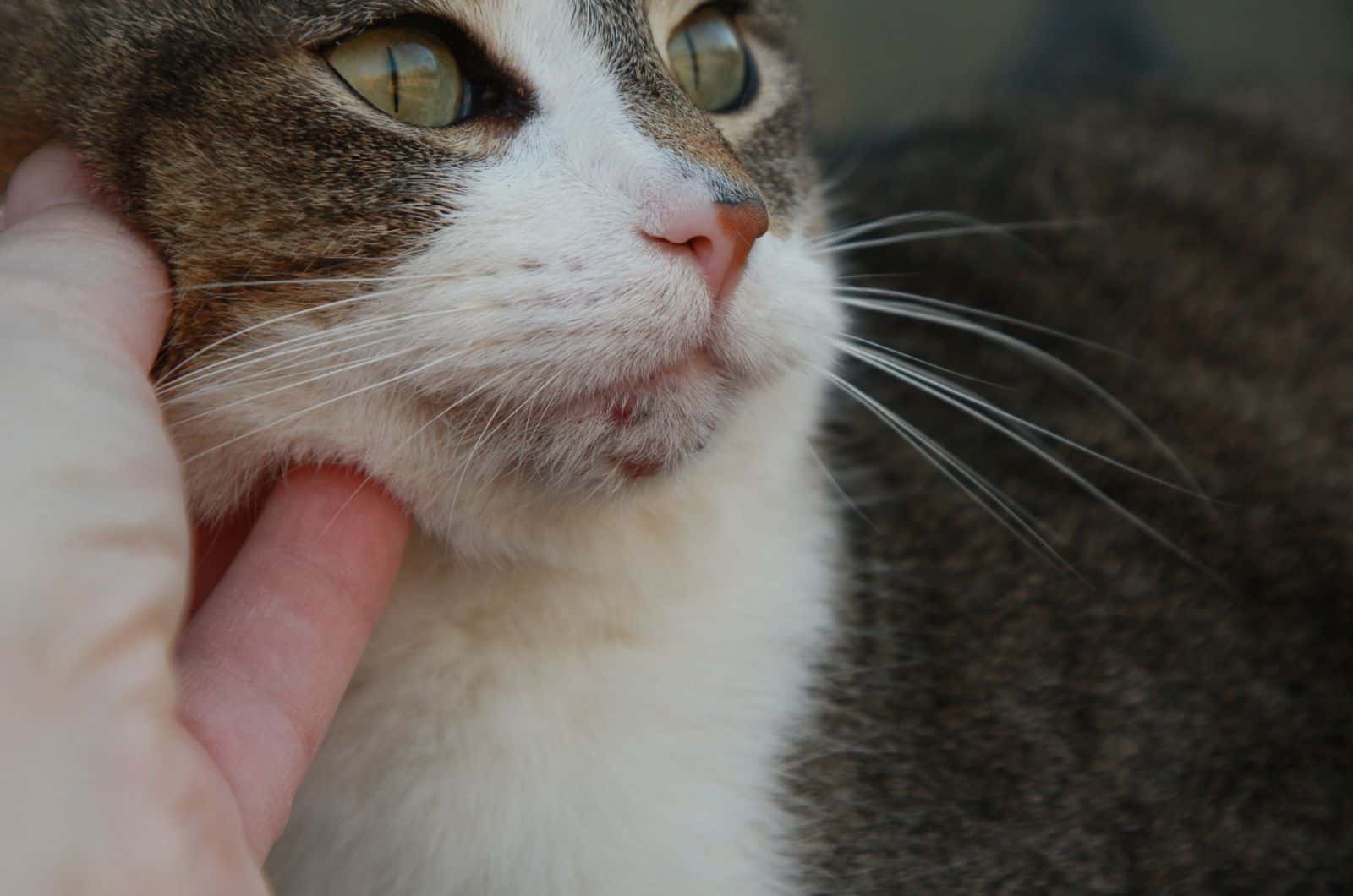
The first time I heard of cat acne was a long time ago when my friend’s male white cat had it. This one summer, he just came home with some black spots on his chin. My friend and I rubbed it with a cat wipe, but it wouldn’t come off. Some of it did, but we couldn’t clean all of it, so we concluded that he didn’t simply get dirty, and this had to be something else.
Now that I’ve learned so much about animals (and cats in particular), I know how to recognize cat acne. Cat chin acne occurs due to inflammation of the skin in that area. The area on the cat’s chin is quite sensitive, and acne can quickly turn into dermatitis if you don’t do anything about it.
Seborrheic dermatitis can occur if you don’t treat your cat’s acne, and because the chin is very sensitive in cats, it often occurs in this area. This type of dermatitis occurs because the cat’s skin gets too oily due to the overproduction of sebum.
Sebum is naturally produced in order to protect the skin from external factors. However, in the areas that are affected by dermatitis, too much sebum is produced.
This is when black specks may appear on the cat’s chin, and this is often mistaken for flea poop on the cat’s chin. In the case of cat acne, the hairs may also appear as if they are glued together; it will look like your cat’s fur is dirty and oily, like it hasn’t been cleaned for days. So, how do you differentiate between the two issues?
You can do this on your own before going to the vet. If your cat has acne, these black specks will be dry, but if you rub them and heat them slightly, they will become oily again.
On the other hand, flea poop on cat chin won’t be oily, they will be dark-red to black colored specks, which will turn red if you put some water on them or rub them with gloves (since flea poop is just digested blood).
The best way to do this is to take a piece of paper, toilet paper, or a napkin (it’s best that it be white so you can see the color clearly) and warm water. Then put some of the black spots onto the paper towel, add some warm water and rub it for up to a minute.
This should give you your answer, but just to be 100% sure, you should also visit the vet. When you open the piece of paper, if you see a dark-red color, you’re dealing with flea poop. If the specks are caused by acne, you’ll see a pale yellow or a light brown because the dry sebum has melted with the heat of the water.
Cat Acne – Symptoms & Causes
Symptoms – the appearance of spots that look like blackheads on your cat’s chin is the first indicator of feline acne. Little crusts can also start to form, and some cats don’t progress past this stage.
In some other cases, however, the cat’s hair follicles become infected, irritated, and inflamed, resulting in irritating, reddish, pus-filled lumps and cysts. Cats suffering from severe feline acne can also develop cellulitis, a bacterial infection that causes painful swollen lips and chin.
Causes – there are many possible causes of cat acne. If you notice any black spots, scabs, or increased itchiness and scratching in your cat, talk to your vet. It is important that a vet examines your cat because they’ll know exactly what the cause of your cat’s health issue is and how to help.
The following are the most common causes of cat acne. While you might recognize these causes yourself, a vet’s confirmation is still necessary before any treatment is given.
1. Plastic Bowls – if your cat is exposed to plastic a lot, it can contribute to chin acne if your cat is sensitive to it. The best option is to get rid of plastic bowls completely and replace them with food and water bowls made of different materials. Stainless steel or ceramic bowls are usually recommended for pets.
2. Allergy – your cat might have a skin allergy of some sort, and since the cat’s chin area is quite sensitive, it is likely that acne will occur here as a side effect of these allergies. If your cat suffers from some kind of allergic reaction, acne is likely to follow.
3. Bacteria – cat acne can be caused by certain bacteria, most commonly the ones that appear in the little cracks of ceramic bowls. This is another reason to always keep your pet’s bowls clean and in good condition.
4. Weak Immune System – your cat may have had some kind of disease in the recent past or may be currently dealing with one. This weakens its immunity. A weak immune system increases the risk of diseases and infections because the cat’s body can’t protect itself. Your vet will probably prescribe some vitamins, which are highly recommended if this is the case with your cat.
5. Viruses – several viral infections and diseases impact the risk of cat acne occurring. If your cat happens to catch the herpes virus or calicivirus, for example, it might be left with some sensitivities, even if it doesn’t have any other symptoms; chin acne can be one of the signs that your cat is (or was) fighting a virus.
6. Stress – Stress doesn’t bring anything good to anyone! Sometimes our cats and dogs (just like us) suffer from stress or anxiety. Skin conditions are closely associated with stress; if your cat happens to be going through something stressful or has had a recent change in its life, some skin issues might occur, including chin acne.
Diagnosis & Treatment
Diagnosis – in order to rule out demodicosis (a parasitic skin condition) and to check if there’s any fungal infection, your vet will probably take a sample of the affected area. Your vet might also do a biopsy of the cat’s skin or perform some other tests if your cat’s case is more severe or chronic.
Treatment – If your cat does have chin acne, you need to be patient as it will take some time for the prescribed treatment to work. The first thing you should do is replace the plastic dishes, or damaged bowls, that might be contributing to the problem.
Then you should remove debris from your cat’s chin by using your fingernails (prewash your hands, of course), a comb, brush, or cloth or towel dipped in warm saltwater. Finally, you should treat your beloved cat with a regular and consistent skincare routine. Read on for a step-by-step treatment method!
1. Eliminate The Cause – before you do anything, you need to visit the vet, because they will assist in identifying the most likely reason for the black specks. This gives you the best chance of treating the problem effectively.
2. Remove Any Black Spots – the most important thing when treating cat acne is to keep the cat’s affected body part clean. A cat’s skin needs to breathe but you also don’t want its fur to get damaged. Now the hardest part of this treatment for any pet parent, is getting rid of those little pepper-like specks.
As I already mentioned, you can use your fingernails (just be sure to wash your hands before you do anything), or use a towel, brush, or comb. A trusty flea comb can come in handy in this situation. The best option is to use a wet towel and warm salt water; this makes it easier to get all the black specks out of cat’s fur.
If perhaps your cat’s chin gets too oily, since acne is little bits of dried oil, you can put a little baby powder on it and it will absorb and make the area dry. If your vet concludes that the cat’s skin is inflamed, you’ll get a prescribed topical treatment that has an anti-inflammatory and antiseptic action.
3. Provide Supplements – another important thing to do after you identify the cause and treat the problem, is to check your cats nutritional intake. This is so important to aid in your cat’s skin regeneration. Your vet will probably prescribe vitamins and other nutrients based on your cat’s medical history and any blood tests that they have done to check for deficiencies.
Remember that these supplements must be used for a prolonged period of time in order to have the intended impact. It is critical to complete all three stages to ensure that your cat’s chin acne is treated effectively. Some cats are prone to this type of acne, so it may reappear in the future if your cat falls ill.
FAQ
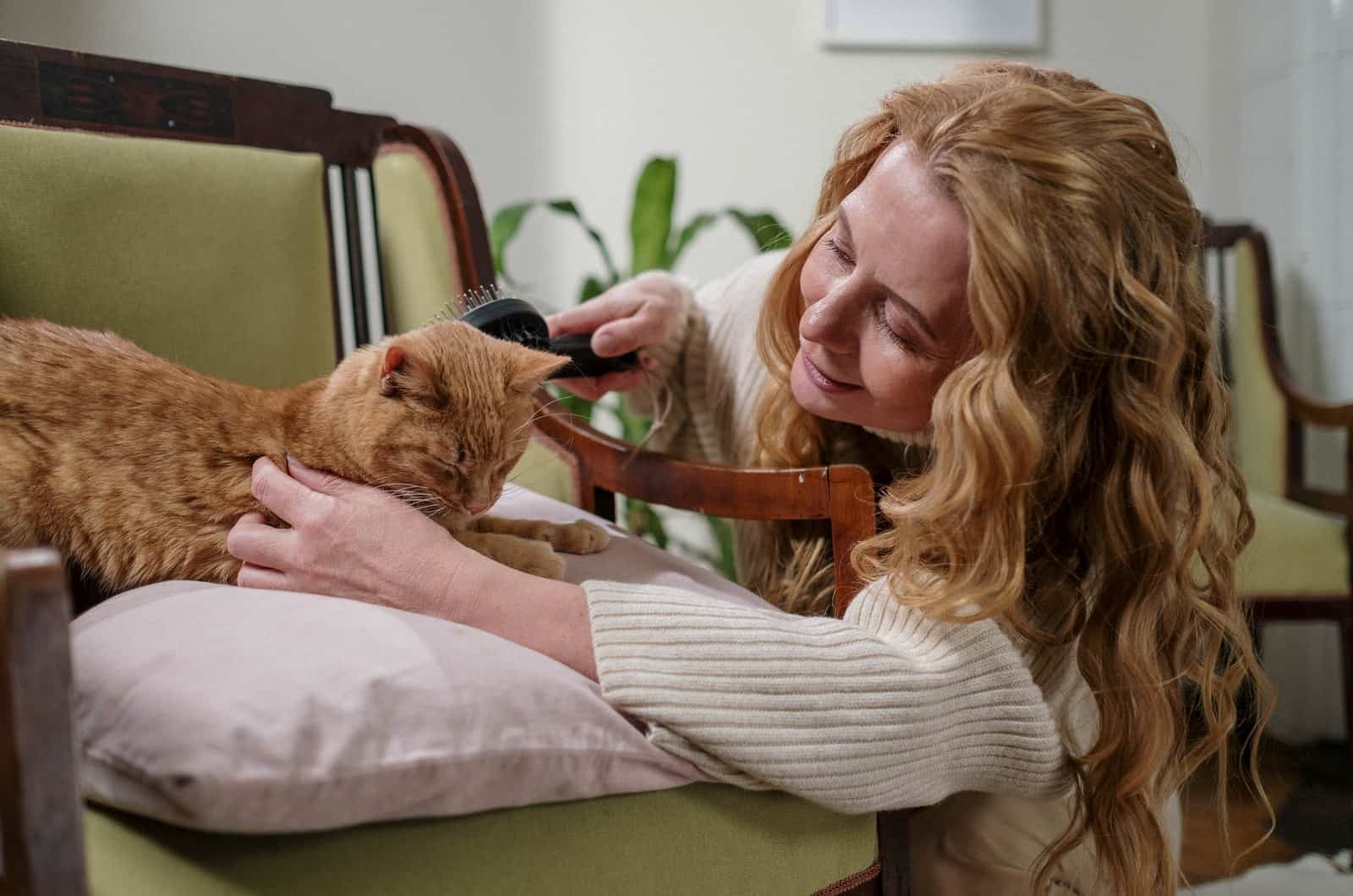
How do you get rid of flea dirt on a cat’s chin?
You must first bathe your cat with a flea-repellent shampoo developed for cats. Bathe and wash your cat well, removing whatever flea dirt you can; if your cat is really dirty, you may need to shampoo multiple times.
Then, using a flea comb, gently go over your cat’s chin and all over the cat’s fur to remove any remaining fleas and flea dirt from the cat’s skin and fur. Again, this step may need to be repeated.
What is this black stuff on my cat’s chin?
Black specks can either be cat acne or flea poop on cat chin. People tend to mistake the two when it happens for the first time. However, if your cat has acne, these black specks will be dry, and rubbing and heating it will make them greasy again.
Flea poop, on the other hand, will be dark-red to black specks that will change to blood-red liquid if you put water on them or wipe them between your fingers as flea poop is merely digested blood.
Can my cat have flea dirt but no fleas?
Yes, and this usually indicates that live fleas were present recently, but maybe you’ve just treated your cat for fleas and it worked, the fleas leapt off or were perhaps cleaned off by your cat while it was grooming.
Can fleas cause chin acne in cats?
Not particularly, but an allergy to fleas can. If your cat happens to have an allergic reaction to fleas (or anything else), it can trigger cat acne. Cat’s chin is a sensitive spot and is prone to developing skin issues, such as acne.
What does flea dirt look like?
Flea dirt looks like little black pepper flecks that are usually round in form. Flea dirt can be found in your dog’s hair or cat’s fur, and also on their skin.
To split the hair and better show flea poop, or reveal the live fleas themselves, run a flea comb or your fingers (wearing gloves) against the direction of hair growth. Flea poop on cat chin will appear as dark-red to black specks that will turn to crimson liquid if you wet and squeeze them.
What causes flea dirt on a cat’s chin?
There is only one cause for flea dirt on the cat’s chin, and that’s fleas! When we say flea dirt, we mean flea poop, therefore the only cause of it can be fleas.
Your pet may have had fleas that went unnoticed, but as soon as you spot them, they need to be eradicated. You need to provide a flea treatment for your pet so it’s essential you consult the vet to find the right one.
How can I tell if my cat has fleas?
You can tell your cat has fleas by finding flea dirt, i.e. black specks in its fur, in the cat bed, or your bed, depending on where your cat spends most of its time. You’ll probably notice that your cat is scratching itself more, usually they will also bite and lick the tail or other parts of the body.
Fleas are extremely irritating, and it gets on a cat’s nerves! If fleas go untreated for a longer period of time, it can even lead to hair loss, behavioral changes, pale gums, and other skin conditions.
Final Thoughts
To wrap it all up, fleas are inevitable but they can be successfully prevented and treated. Many pet owners, especially those who are dealing with this issue for the first time, are unsure if the black spots on the cat’s chin are flea poop or cat acne.
It might be cat acne or flea poop on cat chin. If your cat has acne, the black specks will be dry but rubbing and heating will make them oily again. Flea poop on a cat’s chin, on the other hand, may appear as dark-red to black particles that will transform to blood-red liquid if you wet or wipe it between your fingers (flea poop is just digested blood).
You’re probably wondering how my dog or indoor cat have fleas? Flea infestations are common and may affect any cat (or dog), even if they spend most of their time indoors. You may have taken your cat for a walk or visited the vet clinic, or perhaps another pet visited your home. A flea infestation can happen very easily.
We’ve covered the reasons why people mistake flea poop on cat chin for cat acne, where to look for flea dirt, what causes cat acne, and how to prevent both of these issues. Thank you for reading, and hope you’ll come again since your cat’s health is our priority!
Related Articles:
• Cat Hair Loss On Ears – Should You Visit The Vet?
• Help! My Cat Has Worms How Do I Clean My House
• How Long After Deworming A Cat Are The Worms Gone – Find Out Now!

